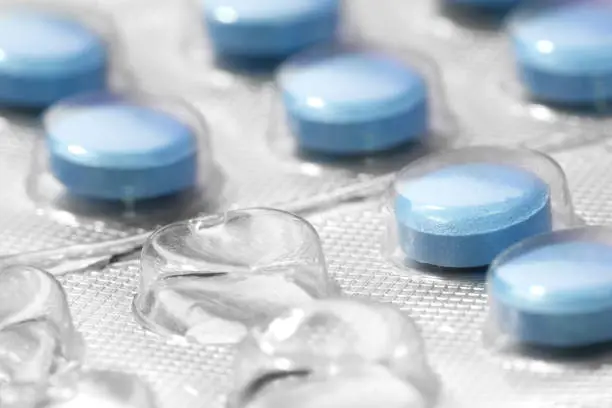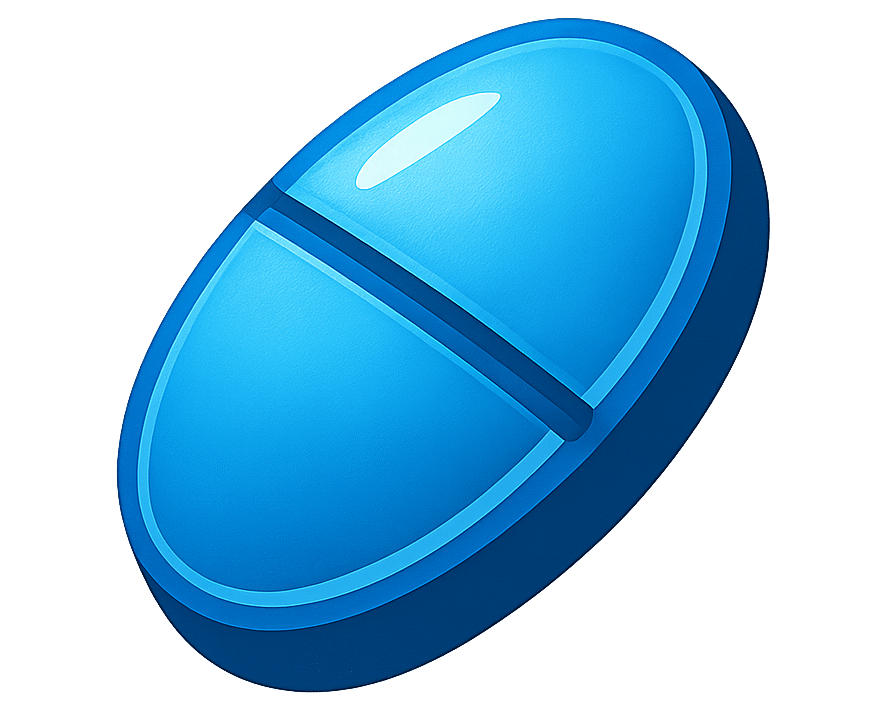
1. The Birth of “Viagra”
The birth of “Viagra” in the 1990s was one of the two major milestones in the field of andrology of that era. It marked the introduction of the first convenient, safe, and effective oral medication in the history of erectile dysfunction (ED) treatment. The authentic “Viagra” family has four brothers: the blue Sildenafil, the orange Vardenafil, the yellow Tadalafil, and Avanafil.
Many authoritative medical studies have confirmed that Viagra-type drugs are the first-line treatment for ED, with an overall efficacy rate of 80% (though sufficient sexual stimulation after oral administration is necessary to enhance erectile function). For andrologists, this is a powerful tool in combating ED.
2. Pharmacological Characteristics
Viagra’s mechanism of action is relatively straightforward—it works by inhibiting the enzyme phosphodiesterase type 5 (PDE5), which is found in high concentrations in penile tissue. By inhibiting PDE5, the level of cyclic guanosine monophosphate (cGMP) in the body increases, relaxing the smooth muscle of the corpus cavernosum, increasing blood flow, and promoting erection. The drug’s effect generally lasts up to 4 hours, with peak effectiveness around 2 hours.
I often refer to this mechanism as a form of “sexual arousal” or “re-perfusion.”
Tadalafil is a long-acting drug that reaches peak blood concentration about 2 hours after ingestion, with a half-life of 17.5 hours and an effective duration of 36–48 hours. It is not affected by high-fat meals. Sildenafil has a shorter half-life and duration—peak concentration is reached 0.5–2 hours post-dose, and its effect lasts 5–7 to 24 hours. Sildenafil and Vardenafil may have reduced bioavailability when taken with high-fat food.
Viagra-type drugs can be used in two ways: one is occasional use, taking a single pill to temporarily improve erectile function; the other is low-dose continuous nightly use, which can improve the microvascular structure of the corpus cavernosum, enhance morning erections, and boost confidence—beneficial for recovery. Personally, I prefer the first method.
Note: The effect of Viagra in patients with diabetes-related ED is often unsatisfactory. Chronic hyperglycemia leads to progressive damage to vascular endothelium, and high blood sugar inhibits endothelial repair, impairing Viagra’s effect. If necessary, a higher dose should be used, along with strict blood sugar and lipid control, and possibly testosterone therapy.
3. Causes of Erectile Dysfunction
Many modern domestic and international andrologists believe that ED is a “disease of peaceful times”—caused by excessive sexual activity, alcohol abuse, rich or greasy diets, indulgent nightlife, and stress. Obesity, high cholesterol, hypertension, cardiovascular diseases, and diabetes are also indirect causes.
Clinical observation reveals that pure deficiency cases of ED are rare; most cases involve a mix of deficiency and excess. Causes include: excessive indulgence and unrestrained desire, depleting kidney essence; improper medical treatment that increases internal heat and damages yin; and injury from diet and emotions, leading to internal phlegm, dampness, and blood stasis obstructing the meridians. Therefore, treatment should not focus solely on tonifying yang. A common mistake patients make is self-medicating with so-called “potency pills.”
4. Viagra Treats the Symptoms, But Root Cause Treatment Is Key
While Viagra is powerful, it’s important to emphasize that most cases of ED are closely tied to overall health. Underlying issues may include cardiovascular, metabolic, or constitutional problems. Therefore, it’s essential to treat both the symptoms and the root cause. Adjusting one’s physical condition, treating primary diseases, changing unhealthy lifestyle habits, and incorporating traditional Chinese medicine (TCM), acupuncture, and moxibustion can significantly improve outcomes.
5. Does Viagra Cause Dependence?
Many patients worry about becoming dependent on the medication or needing to increase the dosage over time. This is a misunderstanding. Viagra does not directly stimulate the brain or central nervous system, and does not cause physical dependence. Numerous studies over the past 5–10 years have shown no evidence of drug addiction.
However, I do not recommend long-term use. The so-called dependence many patients experience is more of a psychological dependence, meaning they mentally rely on the drug for confidence or performance.
6. Important Considerations When Taking Viagra:
(1) Timing of Use
Like other medications, Viagra takes time to reach effective blood levels. For example, Sildenafil requires 30–60 minutes for absorption. Its effects last 4–6 hours. Therefore, it is generally recommended to take the drug about one hour before intercourse (not at the moment of intercourse). Older adults may need even earlier intake due to slower absorption. The ideal window for intercourse is 1–4 hours after taking the medication. Many patients experience reduced effect simply due to poor timing.
(2) Sufficient Sexual Stimulation
Many believe that simply taking the pill will induce an erection. This is incorrect. Viagra is not an aphrodisiac—it requires sufficient sexual stimulation (visual, auditory, kissing, touching, etc.) to be effective. Partner cooperation is crucial in awakening desire.
Patients who take the pill and wait passively for an erection are misunderstanding the medication. Without stimulation, there will be no significant effect, and the drug will not interfere with normal activities.
(3) Correct Dosage
Some men reduce their dosage out of fear of dependence. In fact, for first-time users, it is recommended to take the full dose to ensure effectiveness and build confidence. For those with psychogenic ED, dosage can later be reduced or even stopped altogether.
(4) Don’t Give Up Too Soon
Only 60% of first-time users report satisfaction, often due to misuse, unrealistic expectations, or poor communication. Persistence is key. Research shows that the best effect is usually achieved after 6–8 uses.
(5) Contraindications
Viagra is generally safe, but avoid it in the following situations:
- Unstable angina, recent heart attack, or poorly controlled blood pressure.
- Absolutely contraindicated in patients on nitrates like nitroglycerin.
- Can be taken with antihypertensive drugs, but blood pressure and heart risk should be monitored.
- Absolute contraindication for glaucoma. Discontinue if visual or hearing disturbances occur.
- Use with caution in cases of aortic stenosis, left ventricular outflow obstruction, hypotension, or hypovolemia.
- Vardenafil may slightly prolong the QT interval—caution if on antiarrhythmic drugs.
7. Understanding Reproductive Safety
Multiple studies have confirmed that Viagra-type drugs do not affect semen volume, viscosity, sperm density, motility, or morphology in healthy men. For those with oligospermia, asthenospermia, or teratozoospermia accompanied by ED, these drugs are usable and do not impact fertility. However, I recommend avoiding long-term use, and choosing faster-metabolizing drugs when necessary.
In Conclusion:
Don’t be alarmed when a doctor prescribes this type of medication—it’s not a taboo or shameful treatment. Think of it this way: if sexual desire is like a water pump engine, but the irrigation pipes (blood vessels) are blocked, no matter how hard the engine works, the land won’t be watered. Viagra is the tool to unblock the pipes—nothing more. No illusions necessary.
Choosing authentic Viagra and using it appropriately—understanding indications and contraindications—makes it absolutely safe and effective, but it should always be used under a doctor’s guidance, not through self-determined dosage.
